Cambrian Life Forms
The Earth existed in emptiness and silence for billions of years. No creatures were walking around on it, hunting, making noises or eating. The only entities on the planet were bacteria and other single-celled organisms. After millions of years passed with only micro-organisms, small, soft-bodied multi-cellular invertebrates entered the equation.
A great activity then began manifesting itself on Earth. A large part of the globe was filled with marine organisms, each one very different from that rest, many of which possessed complex characteristics similar to those of organisms today. These walking, hunting, seeing, feeling creatures dominated the Earth. So different were they from one another that none had the same features as any other. The differences were so great that one could not be categorized with the others.
It took a mere 5 million years for this enormous variety to appear. Some of the species then disappeared, leaving only their fossilized remains under the sea.
It is a great miracle created by Allah for any organism to leave all its characteristics on a rock. On occasion, an organism that died and was swiftly buried in sand or silt would sometimes leave all its features mineralized, from its digestive system to its nerve endings. Proof of its existence remains in rocks millions of years old. Allah reveals His glorious creation and creative artistry in whatever manner He chooses. He has provided some of the greatest proofs of this flawless artistry in the fossils of Cambrian life forms.
Say: “Allah’s is the conclusive argument. If He had willed He could have guided every one of you.” (Surat al-An‘am, 149)
Some Preserved Fossils
This section deals with the characteristics of life forms found in Cambrian strata dating back some 530 million years. Latin names are cited in order to provide general information, but the important thing is to demonstrate that the creatures that appeared during this period possessed various complex systems and body parts resembling those of present-day organisms and were sometimes even more specialized. Their remains of around 530 million years ago show that they were created with immaculate details and beauty. They totally undermine the theory of evolution, in allowing us to see what extraordinary entities they were.
For people who believe in Almighty Allah, of course, it’s no surprise to see such sophisticated creatures living some 500 million years ago as well as today. Allah, the Omniscient and Almighty, has the power to create them when He wills, in the form He wills and where He wills.
Allah reveals it in one of the verses of the Qu’ran:
Allah created every animal from water. Some of them go on their bellies, some of them on two legs, and some on four. Allah creates whatever He wills. Allah has power over all things. (Surat an-Nur, 45)
Another reason for focusing on the existence of these life forms and describing their characteristics is to enable evolutionists, who are astonished by the emergence of such creatures in the Cambrian 500 million years ago, to see the truth and to enlighten others who blindly accept what they may have been taught. No process of evolution ever took place in the history of this planet. All the species we shall be examining appeared with no ancestors behind them and possessed complex forms exhibiting no previous developmental phases.
One characteristic of Cambrian fossils is that they’ve been so very well preserved. During fossilization under normal conditions, the hard part of the outer shells, consisting of chitin and calcium, should be decayed or dispersed. Yet in the great majority of specimens collected from Cambrian rocks, the exoskeletons maintain nearly all their original forms, and their owners’ main internal systems can also be seen.
Research in various locations has revealed the different features of all Cambrian fossils. Their heads and bodies, and stomachs and intestinal systems consisting of various complex components have all been preserved. Some have four legs, and others a dozen. Some have shells, others antennae and others gills. In short, almost all body features of organisms in existence today, and even more extinct ones, reveal their presence in the Cambrian seas, with all their wide-ranging appearances and gloriously complex features. Some of these fossils include:
Marrella
Marrella, described as a “lace crab” by Charles Walcott, is one of the most abundant of Burgess Shale fossils. Some 15,000 specimens of Marrella have been collected from Walcott Quarry (named after Walcott) alone. We have a three-dimensional knowledge of just about all this invertebrate’s features. Marrella’s head shield had two pairs of rearward spines that were sufficiently long to extend right along its body. It had two pairs of antennae. One of these was an extension consisting of short segments. The other had a brush-like end. Marrella’s body was composed of increasingly small trunk segments, each of which had a pair of legs. The antennae of this creature, which is thought to have fed on organic matter and small organisms, were probably used to gather up these small elements from the sea floor. The feathery filaments on the outer branch of its legs were used for respiration.72
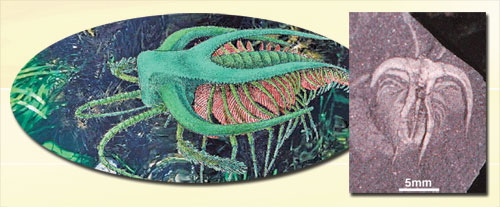
A reconstruction of fossil Marrella and A fossil Marrella
Canadaspis
Canadaspis fossils have been preserved with nearly all their features. The animal’s carapace had two valves literally hinged together. The abdomen, thorax, and intestinal system are completely visible in the specimens. Canadaspis’s legs were divided into two branches. The inner branch was segmented and was used for walking. It ended in small curved claws. The flap-like outer gill branches extended forward of where the abdomen emerged from between the valves. These flap-like extensions were used for locomotion and also for exchanging oxygen. It is thought that it used its feet to dig in the mud in search of organic particles.73
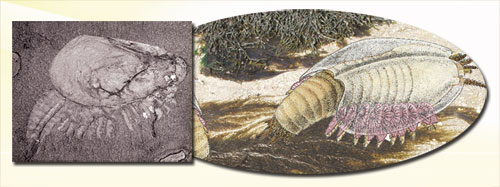
A fossil Canadaspis and A reconstruction of fossil Canadaspis
Hallucigenia
This creature’s spines make it one of the most interesting Shale Burgess fossils. There were tentacles in various parts of its body. It had spines on bulges on the dorsal side of its body. All these tentacles were joined by a narrow tube to the main gut, which extended right along the trunk.With its exceedingly complex structure, Hallucigenia is one of the best examples of how Cambrian life forms differ from those existing today.
The Hallucigenia specimens found in China led to new and even more interesting characteristics of this creature being discovered. The Chinese Hallucigenia fossils contained armored lobes. As can be seen in the illustration on the next page, Hallucigenia rather resembled a caterpillar with lobe-like appendages and isolated plates on its dorsal surface. Newly identified features confirm that the spines were used for defense. Underneath, it had seven pairs of legs, each ending in a claw.74

A fossil Hallucigenia and A reconstruction of fossil Hallucigenia
Odaraia
Odaraia’s structures make it one of the most remarkable Burgess Shale life forms. It had two rather large eyes and two valves meeting along the ventral margin. As an appendage to the abdomen, it had three blades. The animal appears to have been an active swimmer and used its large eyes to seek out smaller organisms for feeding. Odaraia in all likelihood possessed the ability to swim upside down. This way the uneven drag that would otherwise have occurred because of the gap between the valves was minimized. Its appendages provided the power for swimming. The limbs of its head section were small, however there is some evidence of small antennae and a powerful mandible.75
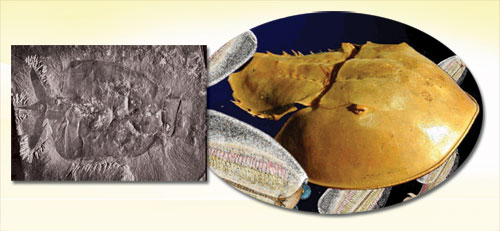
A fossil Odaraia and A reconstruction of fossil Odaraia
Anomalokarid
Anomalocaris, one of the largest Burgess Shale animals, averages 45 to 60 centimeters (17 to 23 inches) in length, although it can sometimes be as long as 1 or even 2 meters (3 to 6.5 feet). Its mouth section resembled a pineapple, and had appendages that helped catch its prey. The largest limbs were attached at the anterior part of the head, and were also probably used for capturing prey. Anomalocaris had teeth in its powerful jaw. The largest known appendages were some 20 centimeters (7.8 inches) in size. It was able to open its jaw in order to admit its prey and possessed various means of drawing its prey into its mouth. Its body was flanked by a series of lobes, which were probably used in swimming.76
Like present-day sharks, Anomalocaris was a hunter perfectly adapted to its surroundings. Scientists have worked hard to determine which phylum the animal can be ascribed to, but finally included Anomalocaris in a phylum of its own.77

A fossil Anomalocaris and A reconstruction of fossil Anomalocaris
Pikaia
Pikaia was first described by Walcott as a marine worm. However, because of several of its features, it was included in the phylum Chordata, which also includes vertebrates. The first known Cambrian representative of this phylum, it had a pair of short tentacles on the front. The trunk consisted of solid blocks of muscle, curved in an S shape. The tail expanded in the form of a fin. Pikaia swam just above the sea bed. It propelled itself by using the muscles to undulate its body.78

A fossil Pikaia and A reconstruction of fossil Pikaia
Opabinia
Opabinia is a creature found in the earliest Cambrian rock beds and possesses characteristics very different from other life forms. It had a segmented trunk and a soft shell. There were five eyes on its head. More interestingly, it had a proboscis on its head, which ended in spines. This was probably used for grasping preys.79Each of the trunk segments had a pair of gills. The hindmost three segments comprised the tail. Thanks to Opabinia, scientists realized that the soft-bodied Burgess Shale fauna was more complex and diverse than they had previously imagined.

A reconstruction of fossil Opabinia and A fossil Opabinia
Insolicorypha
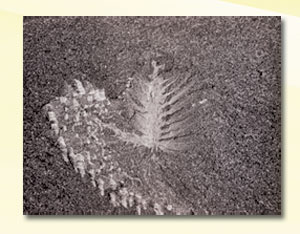
A fossil Insolicorypha
This single fossil specimen from the Burgess Shale formation has been astonishingly well preserved, despite being very tiny. The head part is divided into two sections; both these projections were used for sense perception. The trunk consisted of some 19 segments, and there were three projections on it resembling tentacles. Each of the extensions on Insolicorypha’s body was equipped with 30 to 40 fine hairs. The presence of fan-like hairy extensions on its body shows that the animal must have been an active swimmer. This also explains its rarity, because since active swimmers do not generally live on the sea floor, they may not leave many traces behind. Since it cannot be linked to any present form of life, this creature comprises a family of its own—the Insolicoryphidae.80
Branchiocaris

A fossil Branchiocaris
Branchiocaris had a hard shell consisting of two parts, covering the anterior part of its body. The trunk consisted of 40 divisions. The various appendages on its body were large structures resembling flaps. It had limbs. Its gut is also clearly visible in the fossil specimen.
Branchiocaris had appendages on its head. Short antennae were very strong and curved forward. Another pair of longer appendages was situated beside the antennae and ended in a claw. The trunk appendages are very evident in the specimens. The creature in all probability swam near the sea floor. It probably scavenged on dead or sessile organisms. The claws were used to carry food to the mouth. Its characteristics led to its being classified with arthropods.81
As you can see from these examples alone, Cambrian life forms were flawless creatures living in their own ecosystems and possessed features that were just as complex as those of organisms living today. Phacops, which lived in that period and is classified as a genus of trilobite—and which we shall be looking at in some detail in due course—had eyes with a very superior structure and are no different from those animals alive today.
These details concerning Cambrian life once again show that Darwinism is to be completely discounted. The various complex structures encountered in all kinds of invertebrate marine creatures appearing in this period are among the conundrums that evolutionists are unable to explain. The sudden emergence of vertebrates has made the situation confronting evolutionists even more difficult and problematic.
The Vertebrates That Evolutionists Never Expected!
Vertebrates are defined as organisms with a spinal column and spinal cord, a skeleton consisting of bone or cartilage, a brain protected inside a skull, a closed circulatory system and a heart consisting of two, three or four chambers. They are divided into five classes: fish, amphibians, reptiles, birds and mammals. Widely distributed across the world, their bodies contain a wide variety of highly developed and complex structures.
Vertebrates are a group included in the phylum Chordata. Some members of this phylum are vertebrate and others invertebrate, but all possess a nerve tube known as the notochord. For a great many years, the Cambrian fossil record lacked vertebrate, and for that reason, the earliest vertebrate specimens were thought to belong to the later Devonian.
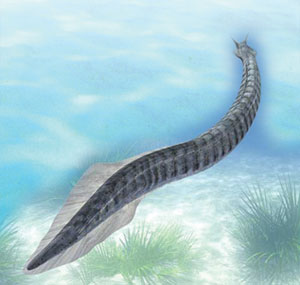
Pikaia
Evolutionist paleontologists believed that vertebrates appeared relatively later than the other main groups, since vertebrates as a group—of which man is also a member—are exceedingly complex in their anatomy. Evolutionists claimed that this group must have appeared in stages and at a relatively late date, and for long used the lack of any vertebrate remains in Cambrian rocks to bolster their position. As the evolutionist paleontologist Stephen Jay Gould admits, Darwinist textbooks particularly stressed the fact that no evidence of vertebrates in the Cambrian had ever been found, seeking to portray this as evidence that Cambrian rocks confirmed the truth of Darwin’s theory of evolution. In their scenarios regarding vertebrate evolution, evolutionists suggested that Pikaia, a Cambrian chordate, was the ancestor of all vertebrates.
Yet as they were soon to see, these claims were unjustified.
Excavations performed in Cambrian rock beds in China produced results that completely overturned evolutionist scenarios regarding vertebrates. The chordate now known as Haikouella, unearthed by the Nanjing Institute of Geology and Paleontology’s Jun-Yuan Chen and his team, possessed a brain, heart and circulatory system, gills, a notochord, a well developed musculature and—in all likelihood—a pair of eyes.
The science journalist Fred Heeren describes how the discovery of Haikouella produced results that were the exact opposite of evolutionist expectations regarding Pikaia:
Biologist had been expecting to see something that would like a primitive ancestor to the middle Cambrian animal called Pikaia, formerly promoted as the world’s earliest chordate. Rather than finding evidence that Pikaia had a less-complex ancestor, Chen instead found a chordate that already displayed many vertebrate characteristics 15 million years earlier.82
Thus it was that evolutionists had to abandon Pikaia, which for decades they had depicted in textbooks as the ancestor of vertebrates. The fact that the first known chordate had a highly developed anatomy and—moreover, that it had lived 15 million years before Pikaia—totally overturned the claimed progression of the theory of evolution. The elimination of this fictitious ancestor thus dealt a severe blow to the scenario of vertebrate evolution.
Yet the real blow came with the discovery that vertebrates had also lived in the Cambrian! These findings were the remains of a fossilized fish, dating back 530 million years, found at Haikou, near Kunming, the regional capital of the Chinese province of Yunnan. These remains literally stunned evolutionist scientists.
Research by Chinese, British, French and Japanese scientists showed that this was indeed a vertebrate. All the details of the animal’s head and backbone could be seen in the remains. Such key features as a lobate extension to the head, eyes and possible nasal sacs provided detailed information regarding the creature.83Many of the vertebrate features were right before scientists’ eyes, and, what is more, in a fossil dating back 530 million years old.84
This fish was given the name of Haikouichthys. Scientists are agreed that it is a true fish because of its gills and the zigzag arrangement of the muscles known as myotomes—features unique to fish.85Besides, Haikouichthys is not the only fossil fish that belongs to Cambrian. Another fossil, known as Myllokunmingia, was unearthed in Chengjiang. Philippe Janvier of the National Museum of Natural History in Paris says that this, too, is definitely a vertebrate and describes its significance:
It’s important because up to now the vertebrates were absent from the big bang of life, as we call it—that is, the great early Cambrian explosion, where all the major animal groups appeared suddenly in the fossil record. ... It is practically certain that these are vertebrates.86
The theory of evolution maintains that organisms emerged gradually, and that their complex structures are expected to appear only toward the end of the fictitious evolutionary process. Given that point of view, the chordate Haikouella and the Cambrian fish Haikouichthys and Myllokunmingia represent major problems, because these animals have reduced by 15 million years the time necessary for the chordate evolution scenario and reduced the time necessary for the evolution of fish by a full 50 million.
Thus, the sudden appearance of these animals has reduced to nothing the time that these organisms supposedly need to evolve.
Naturally, these discoveries caused great astonishment among evolutionist circles, who needed to explain the sudden appearance of vertebrates in the Cambrian Period. This only added another problem to the Cambrian, which was in any case full of question marks. A great many evolutionists have finally had to abandon their previous scenarios regarding the evolution of vertebrates and to admit that on this subject, they have no answers at all.
The Fact Revealed by Fossils

John Maynard Smith
For as long as they have been investigated, Cambrian rocks have continued to reveal the characteristics of brand new organisms, revealing important specimens that enriched the variety of life hitherto known to us and that totally eliminated the groundless idea of any “common ancestor.” For evolutionists seeking an answer to the question of how Cambrian life forms first emerged, the existence of these organisms with previously unknown structures and living habits constituted an enormous difficulty.
The evolutionist John Maynard Smith has described this variety:
But in the Burgess Shale, information about soft parts is beautifully preserved. These fossils have been known for over fifty years, but recently they have been re-examined. It is now clear that there existed in the Cambrian a very wide array of forms, some of which may differ in their basic body plan from anything alive today. It also seems likely that, with a few minor exceptions, all the body plans that exist today were already present in the Cambrian.87
The evolutionist Niles Eldredge, an American Museum of Natural History paleontologist, described this perfect variety and was forced to confess the extraordinary nature of the phenomenon:
[After the Ediacaran] Then there was something of an explosion. Beginning about six hundred million years ago, and continuing for about ten to fifteen million years, the earliest known representatives of the major kinds of animals still populating today’s seas made a rather abrupt appearance. This rather protracted “event” shows up graphically in the rock record: all over the world, at roughly the same time, thick sequences of rocks, barren of any easily detected fossils, are overlain by sediments containing a gorgeous array of shelly invertebrates: trilobites..., brachiopods, mollusks. All of the typical forma of hard-shelled animals we see in the modern oceans appeared ... in the seas of six hundred million years ago.
| Your Deity is One: Lord of the heavens and the Earth and everything between them; Lord of the Easts. (Surat as-Saffat, 4-5) |
After stating that rather than representing evidence for evolution, this is actually a finding in favor of creation, Eldredge went on:
Indeed, the sudden appearance of a varied, well-preserved array of fossils, which geologists have used to mark the beginnings of the Cambrian Period does pose a fascinating intellectual challenge.88

Canada’s Burgess Shale contains countless Cambrian fossils.
Bob Holmes described the fact of the Cambrian in the 18 October, 1997, edition of New Scientist magazine:
Glass skyscrapers, Gothic cathedrals, yurts, Georgian terraces, Shinto shrines, wattle and daub, Victorian railway stations, Bauhaus, igloos, mock-Tudor. Imagine that all the architectural styles that human ingenuity could ever devise appeared during one 35-year period, sometime in the middle of the 15th century. Imagine how today’s historians would be trampling over each other in their eagerness to learn what made that window of profound creativity possible. That’s roughly how palaeontologists feel about the Cambrian explosion.
 In just 35 million years, the blinking of an eye for evolution, animal life erupted in an explosion of inventiveness that far outshines anything the planet has seen before or since.89
In just 35 million years, the blinking of an eye for evolution, animal life erupted in an explosion of inventiveness that far outshines anything the planet has seen before or since.89
“Anything the planet has seen before or since” is certainly a very accurate description for the Cambrian explosion because the most complex of the various ecosystems on Earth emerged suddenly, as a work of art revealing countless examples of intricate complexity. The Cambrian is a time when sophisticated creatures appeared suddenly at a time when there had been no life forms at all, apart from a few bacteria and other single-celled organisms. And the forms that emerged are indeed far more extraordinary than historic buildings or giant skyscrapers.
Of course, this amazing variety is not the product of trial-and-error genetic coincidences, as Darwinists maintain. Each one is an example of the flawless creation of Allah, our Creator:
Allah, there is no deity but Him, the Living, the Self-Sustaining. He is not subject to drowsiness or sleep. Everything in the heavens and the Earth belongs to Him. Who can intercede with Him except by His permission? He knows what is before them and what is behind them, but they cannot grasp any of His knowledge save what He wills. His Footstool encompasses the heavens and the Earth and their preservation does not tire Him. He is the Most High, the Magnificent. (Surat al-Baqara, 255)
| Have they not looked into the dominions of the heavens and the Earth and what Allah has created, and seen that it may well be that their appointed time is near? In what discourse after this will they believe? (Surat al-A‘raf, 185) |
What Is a Complex System?
 Many of the complex organs that first appeared in Cambrian life forms, such as eyes, antennae, limbs, mouth and gut are all complex systems that exhibit a number of basic features.
Many of the complex organs that first appeared in Cambrian life forms, such as eyes, antennae, limbs, mouth and gut are all complex systems that exhibit a number of basic features.
A complex system arises from a large number of smaller components that are all interrelated to one another. At the same time, this system is in a constant exchange and interface with surrounding structures. The parts comprising any complex system are constantly inter-reacting with one another, and it is not enough for a single component to be operating in order for the complete system to function. All of its components need to work together at the same time, in harmony, and in a flawless manner.
The eye is an example of one such complex structure, consisting of a large number of components, each of which is linked to others. Individually, the substructures of the eye cannot make vision possible. In order for the eye to see, all the components have to perform their own individual functions together, and flawlessly.
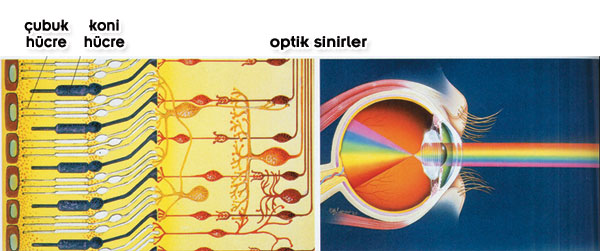
The eye consists of a number of components. In order for this complex system to function and make vision possible, all of its components must work together at the same time. The Cambrian life forms also display complex systems whose existence, some 530 million years ago, is a grave blow to evolution. This once again demonstrates that they did not evolve, but were created.
The complexity encapsulated within any single eye manifests itself similarly in a single cell of a living thing, or even at the fundamental level of a single protein within that cell. This interrelated sophistication is the greatest obstacle facing the Darwinist claim of “small, random changes” as an explanation for the development of species. As we know, random effects are almost always destructive. Any random mutation affecting a complex system will cause the collapse of that system, even if it affects only one of its components. Therefore, a mutation in the optic nerve will cause blindness in the eye. Excessive current—as in a power surge—will damage a radio. No one can imagine that it could turn that radio into a television. Therefore, any random effect impacting on the eye will inevitably damage it.
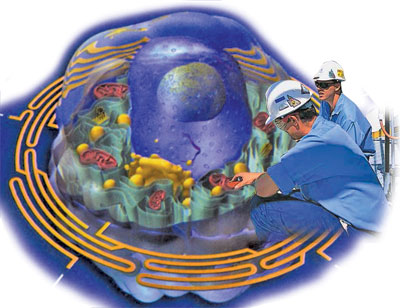
Every cell we possess has complex mechanisms that go far beyond the productive capacities of human engineers. Cambrian organisms were also complex, consisting of many cells with different functions. The fact that they appeared at the beginning of the history of life invalidates the theory of evolution.
Recall that it is Allah Who creates the effects we refer to as random. Therefore, all the phenomena that take place are wholly planned, determined in the destiny set out by Allah. However, some people interpret these as occurring randomly. What they refer to as chance is not independent of Allah. For example, if one throws a handful of dry leaves into the air, each leaf will fall in a specific place. The phenomenon may be referred to as chance. But in fact the place where every leaf will fall is determined in the Sight of Allah. Any random mutation is described as accidental, but it is Allah Who creates both the mutation and its harmful effects.

Any living system contains a far greater complexity than that in any clock.Nonetheless, any random change in any mechanical system, such as a clock, will make it functionless. Such an effect will clearly wreak havoc on a living organism.
As the result of random factors, complex systems are condemned to collapse. The Darwinist philosopher Daniel C. Dennett admits as such:
We consist of billions of cells, and a single human cell contains within itself complex “machinery”” that is still well beyond the artifactual powers of engineers.90
Therefore, biological complex systems can emerge only by being created by Allah, not through coincidental changes. The molecular biologist Michael Denton describes the situation by using an analogy:
In complex systems like a watch or a living system, all the subsystems are intensely integrated. Engineering changes in such systems is complex because each change to any one subsystem must be compatible with the functioning of all the other subsystems. Any change beyond a trivial degree is bound to necessitate intelligently directed compensatory changes in many of the interacting subsystems. In this context, it is hard to understand how undirected evolution via a series of independent changes could ever produce a radical redesign in any sort of system as complex as a living organism. It is precisely this integrated complexity which provides a major barrier to engineering radical change in living things from viruses to mammals.91
The principle that “all the subsystems comprising a complex system are intensely integrated” can also be seen in the early history of the animal kingdom.
The First Complex Life Forms
In terms of Darwinian theory, the Cambrian Period is very early for the high level of biological complexity it exhibits. Darwinists claim that the complex structures possessed by living things are acquired gradually, over long periods of time. Therefore, species must have possessed rudimentary, primitive characteristics at the start of their supposed evolutionary histories and acquired more complex features only at the end of a very lengthy evolutionary process.
| Allah'ın, gökte ve yerde olanların hepsini bilmekte olduğunu bilmiyor musun? Gerçekten bunlar bir kitaptadır. Hiç şüphesiz |
In fact, however, the history of animals presents the exactly opposite picture. The first animals shared the same basic body structures as those living today; and the same complex organs such as eyes, antennae, limbs, mouths and guts. Therefore, complexity is a characteristic that came early in animal history, rather than late. To be more accurate, it existed right from the start.
This, no doubt, is a great puzzle for evolutionists. The evolutionist researchers Marshall Kay and Edwin H. Colbert state that this state of affairs is highly baffling:
The introduction of a variety of organisms in the early Cambrian, including such complex forms of the arthropods as the trilobites, is surprising . . . The introduction of abundant organisms in the record would not be so surprising if they were simple. Why should such complex organic forms be in rocks about six hundred million years old and be absent or unrecognized in the records of the preceding two billion years? . . . If there has been evolution of life, the absence of the requisite fossils in the rocks older than the Cambrian is puzzling. 92
By hiding behind the concept of a “puzzle,” these evolutionist researchers are trying to gloss over that all these systems emerged suddenly, hundreds of millions of years ago—a fact that is enough to completely repudiate Darwinism. To show why this early complexity has such a devastating effect on Darwinism, it will be useful to compare some examples from the Cambrian ecosystems with pre-Cambrian complexity—and to examine the trilobite, one of the early complex life forms, and the perfect and highly sophisticated structure of its eye.
Cambrian Ecology and Suddenly Appearing Predators
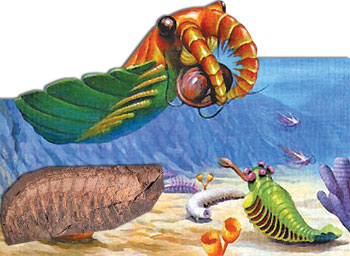
The complex equipment possessed by the Cambrian life forms also shows that they were predators.
Among the most striking features of Cambrian species are the advanced organs they possess for attack and defense, in complex prey-predator relationships. That Cambrian life forms were equipped with such advanced weaponry, though there is no sign of such structures in the pre-Cambrian, demonstrates that this development of complexity was sudden and comprehensive.
The defense systems possessed by Cambrian creatures reveal that the Cambrian ecosystem was highly developed. Jun-Yuan Chen says that the Cambrian ecology, which emerged and grew very quickly, was just as developed as today’s:
Anomalocarid gibi canlılar, erken Kambriyen'de dahi çok gelişmiş, büyük, iyi uyum sağlamış avcılar bulunduğunun belirtisi. Bu da Kambriyen ekosistemlerinin günümüzde gördüklerinizden o kadar farklı olmadığını gösteriyor. Yaşam alanlarını farklı organizmalar dolduruyordu ama bunların yapılanması aynıydı.93
Nanjing Jeoloji ve Paleontoloji Enstitüsü'nden Jun-yuan Chen ise benzer bir değerlendirmesinde, hızla ortaya çıkıp büyüyen Kambriyen ekolojisinin günümüzdeki gibi gelişmiş olduğunu ifade etmiştir:
[In the Cambrian], there was a highly developed ecosystem. The food chain was as complicated as it is today.94
The predators that appeared suddenly in the Cambrian reveal an evident conflict with Darwinism’s concept of gradual development. Darwinism is based on the hypothesis of gradual development and countless intermediate forms in the fossil record and therefore, having incomplete, marginally functional structures. Similarly, it requires the remains of developing, but still half-formed complex attack and defense systems during the Cambrian Period. Yet these life forms were created suddenly, with completely functional and perfect structures for attack and defense.
The evolutionist writer Richard Monastersky describes the hollow nature of the hypothesis of gradual development:
People regarded the Cambrian as a rather early stage in the development of ecosystems. The assumption was that predation wouldn’t have been a very well developed strategy.According to this theory, the earliest predators would have started off as relatively simple creatures that then evolved more specialized features over many millions of years. As the predators added to their offensive weaponry, prey would evolve sophisticated defense systems.But the fossils show that the arms race accelerated almost overnight during the Cambrian explosion. Creatures with hard shells and long spines abound in the Chengjiang fauna, displaying a broad sweep of protective armor. Likewise, Anomalocaris appeared on the scene with an array of formidable feeding tools.95
The complexity that Cambrian fauna displays clearly and definitely repudiates the claims of the theory of evolution, because, in both fauna and on the species level, the theory demands considerable development from the simple to the more complex. Paleontologists who discover fauna that lived millions of years ago have to arrange them in terms of their relationships with one another and their environments, from the simple to the complex in order to demonstrate that any evolution occurred. However, Darwinism has been unable to provide any evidence for such evolution.
Species as complex as those of the Cambrian appeared not in the wake of simpler faunas extending in a vertical line up through geological strata, but in a unique and isolated manner. In the face of these facts, the only rational explanation that one can offer is that Allah created Cambrian fauna with all its complexity.
Genomic Complexity
The anatomical variety that suddenly appeared in the Cambrian spells out an explosion of the information in the DNA of those living things. A single-celled eukaryote of the pre-Cambrian is an internally specialized and complex structure, with a nucleus and various organelles.96However, it ultimately represents just one type of cell. A trilobite or mollusk, on the other hand, contains dozens of different tissues, each of which is made up of a specialized cell type.95 Based on the present-day specimens of some species that first appeared in the Cambrian phyla, we can conclude that they typically contain between 40 and 60 different cell types. New cell types require the existence of several new, specialized proteins. For example, a cell on the inner surface of the intestine that secretes a digestive enzyme needs—at a bare minimum—structural proteins that modify its shape, regulatory enzymes that control digestive enzyme secretion, and the digestive enzyme itself.97
| De ki: "Göklerde ve yerde olanlar kimindir?" De ki: "Allah'ındır." |
New cell types require the existence of several new, specialized proteins. For example, a cell on the inner surface of the intestine that secretes a digestive enzyme needs—at a bare minimum—structural proteins that modify its shape, regulatory enzymes that control digestive enzyme secretion, and the digestive enzyme itself.98New proteins require new genetic information encoded in the DNA. Therefore, any increase in the number of cell types means a significant increase in specialized genetic information. It is impossible for an organism to acquire by chance a gene that will produce a needed protein.
Frank Salisbury, an evolutionist biologist, says the following about this impossibility:
A medium protein might include about 300 amino acids. The DNA gene controlling this would have about 1,000 nucleotides in its chain. Since there are four kinds of nucleotides in a DNA chain, one consisting of 1,000 links could exist in 41000 forms. Using a little algebra (logarithms) we can see that 41000 = 10600. Ten multiplied by itself 600 times gives the figure 1 followed by 600 zeros! This number is completely beyond our comprehension.99
| Sana, hilalleri (doğuş halindeki ayları) sorarlar. De ki: "O, insanlar ve hacc için belirlenmiş vakitlerdir. İyilik (birr), evlere arkalarından gelmeniz değildir, ama iyilik sakınan(ın tutumudur). Evlere kapılarından girin. Allah'tan sakının, umulur ki kurtuluşa erersiniz.Sizinle savaşanlara karşı Allah yolunda savaşın, (ancak) aşırı gitmeyin. Elbette Allah aşırı gidenleri sevmez. |
Molecular biologists estimate that a cell of only minimal complexity would require between 318 to 562 kilobase pairs of DNA (kilobase: 1,000 bases, in expressing the lengths of nucleic acid molecules) to produce the proteins necessary to maintain life.100 More complex single-celled organisms require 1 million base pairs. However, any complex animal requires thousands of times more coded instructions. In the genome of the fruit fly Drosophila melanogaster, for example, there are up to 120 million base pairs. Therefore, there must be an enormous increase in complexity of genetic information for any transition from a single-celled to multi-celled form.
Computer programs, to use an analogy, are written by thousands of people and then tested. The genomic complexity in multi-celled organisms is far more complex than any program written by human beings. No doubt that a program that cannot be produced by even the most highly advanced technology, and its sudden appearance in the DNA of Cambrian life forms millions of years ago, cannot be explained in terms of chance. That would be like claiming that the highest computer technologies achieved so far could result from a lightning strike on a pile of scrap metal.
In other words, it would be nonsensical. Therefore, it’s completely irrational to resort to claims of aimless natural phenomena to explain the origins of Cambrian life forms.
A computer program requires an outside consciousness—in other words, a computer engineer—to bring it into being. It’s certain that the complexity in Cambrian life forms, unmatched by the most advanced computer programs, can be explained only by the existence of an omniscient Creator. The genomic complexity of Cambrian life forms was created by Almighty Allah, Lord of the worlds, and not by chance.
The Trilobite: A Flawless Cambrian Life Form
Stephen Jay Gould has described this as “everyone’s favourite invertebrate fossil,”.101because the trilobites were uniquely attractive creatures, the best preserved member of the marine arthropods, with a sculpted appearance and dazzling complexity. With their eyes consisting of many lenses and a perfect structure allowing them to see and hunt, and their ability to swim and feed in the silent seas of 530 million years ago, they were prolific and are commonly found in fossil beds. They also present one of the greatest disappointments facing Darwin and his supporters in later years, and one of the greatest problems they need to overcome.
As we mentioned before, with few exceptions, soft tissues are seldom preserved because they represent food for predators. Also bacteria are microscopic predators, ready to decay tissues as soon as organisms die, wherever they may be. They feed on such organic substances throughout their lives.102
That is why we cannot obtain complete knowledge of how an extinct life form lived, which organs it used for what purpose, or the structure of those internal organs. Only the fossil remains they have left behind can give us any information to learn about them and understand the general systems they possessed.
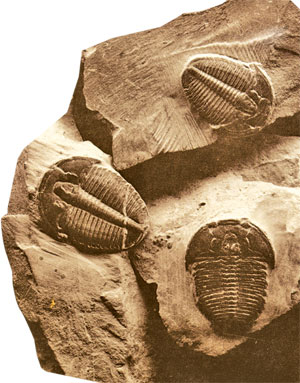 Yet when it comes to Cambrian life forms, the picture is very different. In the great majority of cases, these creatures’ soft tissues have been so well preserved that we can establish how they lived and fed, whether or not they were predators, and whether they were fast swimmers. Trilobites were invertebrates that lived in various parts of the world and have left behind the greatest number of traces from the Cambrian Period. For that reason, by comparing all these specimens, it has been possible to reconstruct their lives in considerable detail.
Yet when it comes to Cambrian life forms, the picture is very different. In the great majority of cases, these creatures’ soft tissues have been so well preserved that we can establish how they lived and fed, whether or not they were predators, and whether they were fast swimmers. Trilobites were invertebrates that lived in various parts of the world and have left behind the greatest number of traces from the Cambrian Period. For that reason, by comparing all these specimens, it has been possible to reconstruct their lives in considerable detail.
Trilobites represent a subphylum of the phylum Arthropoda. Their hindparts were divided longitudinally into three lobes (which is where the name trilobite comes from). A shell made of keratin covered their head and body. Like present-day arthropods, these creatures grew by molting, or shedding their shells. In sheer numbers, trilobites represent more than half of all Cambrian fossils, and their shells have been exceptionally well preserved. With their detailed body structure and their perfectly developed form, sensitive nervous system and compound eyes, they emerged together with many other similarly complex phyla at the beginning of the Cambrian explosion.
The longest section of a trilobite was its thorax. This region consisted of various segmented sections, all joined together. Each was connected to the adjoining ones with a hinge, forming a linked system like railway carriages. They were interconnected by a coupling, which allowed flexibility. Thanks to their segmented body, these creatures could easily move over obstacles, flex and turn.103
Looked at in close up, the trilobite’s tail also consisted of a few segments, but these were not free but were fused together. In some trilobites, the tail section is longer than the head, consisting of a large number of segments.104
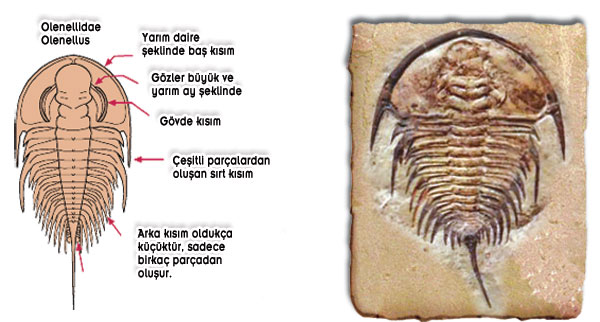
Pairs of appendages protruded from each section of the trilobite. Jointed legs, branchial appendages and a segmented structure containing the internal organs made up the thorax. The head, with its complex eyes, also possessed antennae, which served as feelers.
Present-day species consisting of various segments are very similar to the trilobite. Beetles, shelled animals, centipedes and spiders all consist of a number of consecutive segments and also share another feature with trilobites: jointed legs. At first sight, it may be difficult to see much resemblance between the legs of a fly and those of a lobster, but both are actually jointed in the same way. Every joint can bend and turn around its own axis.
Animals with jointed legs are known as arthropods, for which reason trilobites are also classed as a form of arthropod.
From each section comprising the trilobite emerged a pair of appendages. Generally, that section containing the internal organs lay in the middle of the organism. Outside the legs were three other branches. The two outer ones were the branchial appendages—gills that the trilobite used to breathe and absorbe oxygen in the sea water, just as all arthropods must do.105
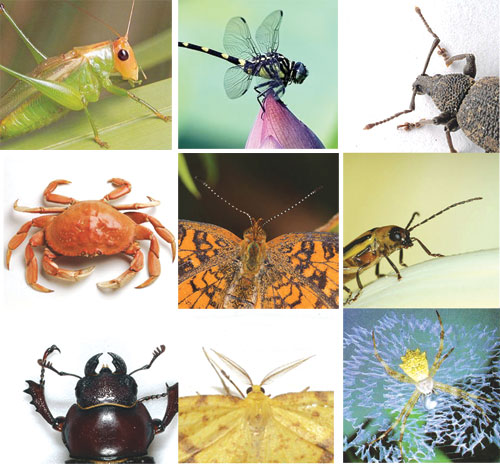
The trilobite, the oldest jointed-legged member of the phylum Arthropoda, resembles present-day organisms in many respects. They share their jointed legs and segmented bodies with beetles, shelled organisms, spiders and centipedes. In terms of complexity, the trilobite is the equal of living things today, and its eye structure is actually superior to that in some.
Examined under magnification, the antennae projecting from the trilobite’s head were noticed. Again, they consisted of segments, and were the advance guard of the arthropod body. These antennae performed the tasks carried out by the fingers and nose, and permitted the creature to acquire detailed knowledge of its surroundings. In the trilobite, these structures were incomparably more complex than in any pre-Cambrian life form.
One organ in particular had a structure that optic physicians dream of: The trilobite eye, which exhibits a flawless creation.
Amazing 530-Million-Year-Old Eyes
Large or small, just about every animal swimming in the sea, flying in the air or living on the land has been equipped with eyes. It comes as no surprise that a tiny fly or a crab has eyes letting it perceive its surroundings.
Yet the discovery of eyes on an arthropod 530 million years old is an extraordinary state of affairs that is difficult for evolutionists to believe. The eye, described by Darwin as an “organ of extreme perfection and complication"106, existed in an astonishing and complex form at a time when—according to him and his followers, there should have existed no complex life forms at all. The trilobite’s eye has shown scientists a great many perfect details that appeared during the Cambrian.
| Your Lord is Allah, Who created the heavens and the Earth in six days and then settled Himself firmly on the Throne. He covers the day with the night, each pursuing the other urgently; and the sun and moon and stars are subservient to His command. Both creation and command belong to Him. Blessed be Allah, the Lord of all the worlds. (Surat al-A‘raf, 54) |
The trilobite eye’s most important distinguishing feature is calcite, one of the commonest minerals on Earth. Limestones consist largely of calcite and are the raw materials for buildings that stand for long periods of time. Calcite is the building block of pyramids, amphitheaters and historic columns that have survived the centuries down to the present day. The floors of Renaissance churches in Italy were made out of calcite. In short, stones rich in calcite were used throughout history for almost everything that needed to be attractive and hard-wearing.
The trilobite eye was composed of transparent calcite crystals—a feature that makes them unique in the entire animal kingdom.107
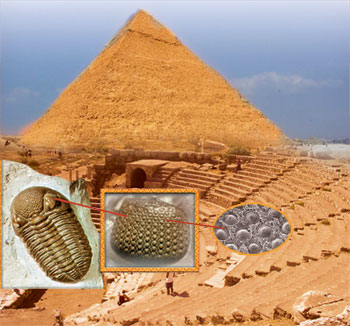
The main distinguishing feature in the trilobite’s eye is calcite. This mineral has let the building blocks of the pyramids and ancient amphitheaters survive down to the present day, and comprised the animal’s compound eyes. This special structure makes trilobites unique among all living things.
If you fracture a large piece of calcite crystal, you can see that it breaks along a regular plane, in line with its own atomic structure. What is left in your hand is a six-sided crystal, which allows light to pass through it. Calcite was specially created in order to perform this superior visual function in the trilobite.
The reason why the trilobite’s calcite structure makes its eye so unique is that other arthropods mostly have soft eyes. Since a trilobite’s calcite eyes have a structure similar to other hard parts of its body, they too have been well preserved. All the trilobite specimens obtained so far have provided comprehensive information about the eyes’ perfect and detailed structure.
The eyes were on top of the cheek of the animal and consisted of a large number of lenses.108Rather resembling a honeycomb, these lenses are just about as clear as a dragonfly’s. More interesting is the fact that they were fused together at the front of the animal.109
Trilobites’ eyes had another arthropod trait: their compound structure. These eyes contained numerous sub-units, each of which was a lens. Just like those in a fly’s compound eyes, each hexagonal unit served as an independent lens. Each one perceived a different image, which image was then combined into a whole. The only difference between a fly’s and a trilobite’s compound eyes is that the trilobite’s was made up of calcite, a mineral.110
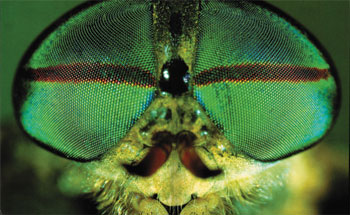
The trilobite had the same compound eye structure as that of the present-day fly, shown above. Some species of trilobite had thousands of lenses in their eyes. Every lens perceived a separate image of the region it focused on. The greater the number of lenses, the greater the resolution of the image. These perfect eyes, dating back half a billion years, are a marvel of flawless creation.
A trilobite eye is a miraculous construction of small, slender prisms. Each wide, hemispherical eye may have hundreds or even thousands of lenses, each of which perceived an image from a different direction. Some faced straight forwards, others to the side, and some even faced backward. Each lens focused on an area determined for it. The trilobite was thus able to perceive danger approaching from any direction, and also possessed a great advantage when hunting.
The average trilobite lens was long and thin, a few tens of thousandths of a millimeter across and hexagonal in shape. With their special geometry, the hexagons exhibited a perfect structure on the eye’s sloping convex surface. In order for that curve to be established and for a little space to be made around it, a few rare lenses had other shapes, and there were also variations in their arrangements.111It has been realized that the trilobite’s eye worked in the same way as those of present-day arthropods.
Since every lens “saw” a particular pre-selected field, the trilobite perceived the world as a mosaic of small images. The shape of any object before it must have varied slightly from lens to lens, with a different image produced by each one. The resolution of the images perceived also depended on the number of these lenses. More lenses of course meant better vision.
One of the most difficult jobs I ever attempted was to count the number of lenses in a large trilobite eye. I took several photographs of the eye from the different angles and then made enormous prints magnified large enough to see individual lenses. I started counting as one might, “One, two, three, four. . . ” and so on, to a hundred or two. The trouble was that you had only to look away for an instant, or sneeze, to forget exactly where you were, so it was back again to “One, two, three...”
...” ... I got to a total of more than three thousand before I vowed that, in future, I would simply estimate the number of lenses in a bit of an eye, and use my best arithmetic to estimate the whole number.112
More than 3,000 lenses means that the animal received more than 3,000 images. This clearly shows the degree of the complexity in the eye and brain structure of a creature that lived 530 million years ago. This flawless structure cannot have come into existence through evolution, as is set out by David Raup, a professor of geology from Harvard, Rochester and Chicago universities:
Thus the trilobites 450 million years ago used an optimal design which would require a well trained and imaginative optical engineer to develop today—or one who was familiar with the seventeenth-century optical literature.113
The Superior Complexity in Phacops Trilobites

Huygens (left) ve Descartes (right)
Trilobites of the genus Phacops have a large number of lenses. Rather than being hexagonal, the shape of these lenses is more reminiscent of a marble’s. If you gaze through a clear marble, you perceive an indistinct image that is reversed and blurred, showing objects to the sides elongated out of proportion. The reason for this is that light passing through a spherical structure is refracted at different angles. Therefore, it can be assumed that the problem of lack of focus in the marble should also be expected to arise in Phacops’s eye. But such is not the case!
In 1972, Kenneth M. Towe of Washington’s Smithsonian Institution showed just how efficient the Phacops eye actually was. Towe managed to obtain an image from inside the trilobite’s lenses and reflect it onto photographic paper. Contrary to his expectations, he encountered an exceedingly sharp image. It was as if the laws of physics no longer applied here.
The truth was only realized several years later. The trilobite eye did not actually ignore the laws of physics at all. On the contrary, it overcame any indistinctness thanks to a plan based on those same laws. Riccardo Levi-Setti solved the mystery of how this happened.
The trilobite was an ideal subject of research for Levi-Setti, a professor of physics at Chicago University and also a fossil hunter. He was familiar with fossil trilobites and, using his knowledge of physics, he made a most interesting scientific discovery. The trilobite lens had a similar structure to the optical constructions worked out by Descartes and Huygens in the 17th century.114 Levi-Setti published his findings together with his paleontologist colleague Euan Clarkson from Edinburgh University. In later years, he turned his research into trilobites into a book.
René Descartes was a French philosopher and mathematician. Christiaan Huygens was a Dutch astronomer and physicist. Both carried out physical and mathematical investigations into the refraction of light, and investigated the ideal shape of telescope lenses. Thanks to two mathematical functions with four variables that each discovered independently of the other, they played a major role in the development of better telescopes, and thus advanced the science of optics. However, they were quite unaware that they were using lenses based on the same mathematical principle that trilobites had been employing, millions of years before the science of optics was ever dreamed of.
Niles Eldredge, a prominent evolutionist and curator of the Department of Invertebrates, American Museum of Natural History, summarized this astonishing state of affairs:
These lenses—technically termed aspherical, aplanatic lenses—optimize both light collecting and image formation better than any lens ever conceived. We can be justifiably amazed that these trilobites, very early in the history of life on Earth, hit upon the best possible lens design that optical physics has ever been able to formulate.115
Richard Fortey, a researcher at the Natural History Museum in London and a professor of palaeobiology at Oxford University, said this about the trilobite genus Fallotaspis:
We know that the first trilobites already had a well-developed visual system. Indeed, the large eyes found in the genus Fallotaspis, from Morocco, prove that sophisticated vision goes back at least 540 million years to the Cambrian period.116
The Problem and Its Solution
A spherical lens like a marble does not produce a clear image, because the rays reaching its rounded surface must travel different distances, and are thus refracted at different angles. The trilobite eye overcomes this problem by means of a special arrangement. As already mentioned, the trilobite eye lens is made of calcite, the same material, as the shell covering its body. Raw calcite crystals are transparent, allowing light to pass through. Each calcite lens in the trilobite eye is biconvex in shape, that is, convex on both sides.
At the bottom of the lenses, Levi-Setti and Clarkson encountered an extraordinary state of affairs. Every lens actually consisted of two units. The upper lens unit was made of calcite, and the bottom was chitin-based. Descartes and Huygens’ mathematical designs and the actual intermediate surface where the two units came together in the trilobite eye lens were in remarkable accord with one another. Magnesium atoms were arranged along the length of this surface in the lens, in sufficient quantities to overcome the spherical aberration. Thanks to these atoms, every light beam curved to the left was balanced by one to the right, thus enabling light rays initially refracted at different angles to focus on the same spot. (See diagram opposite.)
Levi-Setti expressed his amazement at the situation:
In fact, this optical doublet is a device so typically associated with human invention that its discovery in trilobites comes as something of a shock. The realization that trilobites developed and used such devices half a billion years ago makes the shock even greater. And a final discovery—that the refracting interface between the two lens elements in a trilobite’s eye was designed in accordance with optical constructions worked out by Descartes and Huygens in the mid-seventeenth century—borders on sheer science fiction .117
Extraordinary Sensitivity
The creation in the trilobite lens reveals an extraordinary sensitivity in terms of the calcite and chitin refractive indexes. (Refractive index is a measure for how much the speed of light is reduced when passing from one medium into another. For instance, the refractive index of air is 1, of glass 1.5, of water 1.33, and of diamond 2.42.) The refractive index of calcite is 1.6, and that of the chitin beneath it is 1.53.
Huygens and Descartes’ lens designs provide an ideal eye structure, and the trilobite’s eye is highly compatible with those designs. However, Huygens and Descartes’ designs were based on the existence of just one unit. But one unit is not enough for the trilobite eye, because the refractive index of the water in which trilobites lived is different from that of the air.
This is where the usefulness of the bottom lens unit comes in. The deviation that occurs in a water environment is overcome by this second unit—which only goes to demonstrate the complexity in the structure in question.
Levi-Setti stated the following about this property of the trilobite lens:
There is in fact only one choice of indices for which the lens brings an incident parallel beam to a focus. This involves the upper lens being made of calcite (n=1.66) and the intralensar bowl being made of chitin (n=1.53)
In addition, the mathematical solution in the trilobite lens is based upon several laws and principles. Levi-Setti says:
Trilobites had solved a very elegant physical problem and apparently knew about Fermat’s principle, Abbé’s sine law, Snell’s laws of refraction and the optics of birefringent crystals.118

The lens design by Descartes (above left) for maximum clarity also existed in the lens of a trilobite species (above right).The light rays (yellow) enter the lens from the left and are focused on a single point on the right of the lens (blue), thanks to the delicate curvature. Descartes’ lens consists of one single part. In the trilobite, however, there was an additional unit of chitin (white). A number of magnesium atoms were arranged along the intermediate surface between the two units. As the light passed through the upper lens unit (blue), the white section facilitated the focusing of the light onto a single point.
It would, of course, be irrational to claim that a prehistoric animal could possess any knowledge of the laws of optics as set out by Levi-Setti. It is impossible for a trilobite to have known anything on this subject nor, moreover, to produce a flawless structure in its own body in the light of that knowledge. It is Allah, the Creator of all living things, Who gave the trilobite these properties.

The lens design by Huygens for maximum clarity (above left) also existed in the lens of a trilobite species (above right). It serves the same function as Descartes’, but with a different curvature, and collects the light on a single point. The trilobite eye again had an additional unit of chitin (white).
As you have seen, the trilobite’s lens structure, the material of which its lens units were made and the connecting interfaces were just as they needed to be. Moreover, these features were made possible by their being in complete agreement with the laws of physics and optics, and being applied in a perfect fashion. In his article Conflicts between Darwin and Paleontology, the paleontologist David M. Raup writes:
But if we look at the individual elements of the trilobite eye, we find that the lens systems were very different from what we now have. Riccardo Levi-Setti has recently done some spectacular work on the optics of these lens systems . . . The shape is nearly identical to designs published independently by Descartes and Huygens in the seventeenth century. The Descartes and Huygens designs had the purpose of avoiding spherical aberration and were what is known as splenetic lenses. The only significant difference between them and the trilobite lens is that the Descartes and Huygens lenses were not doublets—that is, they did not have the lower lens. But, as Levi-Setti has shown, for these designs to work underwater where the trilobite lived, the lower lens was necessary.119
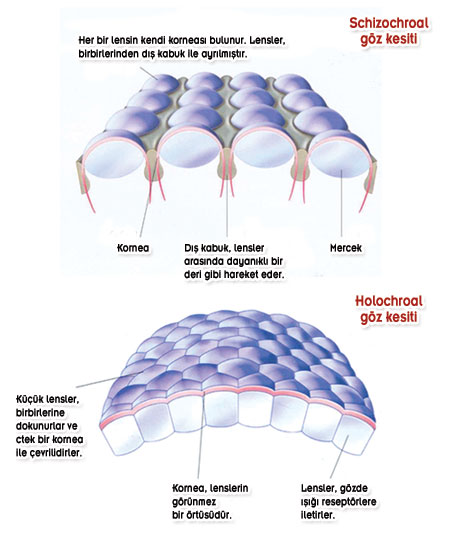
The two major types of trilobite eyes: schizochroal and holochroal. This varied according to the species. Each type of eye was enormously complex.
The Trilobite Eye Is a Marvel of Creation
The trilobite eye’s exceedingly complex structure exhibits the most perfect details. Its components are linked to one another with the most sensitive arrangements, which makes the eye a fully functioning whole. These arrangements reveal a whole chain of miracles: The lenses are specially made out of calcite and chitin, and the refractive indexes of the two substances are perfectly compatible. Had there been some other substance besides chitin beneath the lens, then this perfect focusing would not be possible. Or if the calcite were in another form than crystalline, the lenses would not be transparent. Were it not for the double lens structure, if there were only the upper lens unit composed of calcite, the trilobite would be unable to see under water, and its eyes would serve no purpose. If the intermediate surface between the calcite and chitin units were different from that calculated by Huygens and Descartes, then light could not be focused so accurately. Or if there were any more or fewer magnesium atoms set out along the course of that surface, then the lenses could not correct the light refraction. Even if all the other conditions had been met, the eye would still be unable to serve any useful purpose.
This sequence of miracles inevitably raises a number of important questions:
How did the trilobite acquire this optic system? How did calcite come to form lenses so perfectly installed in the animal’s eyes? How did the chitin and magnesium atoms come to be arranged in the right combinations beneath these lenses? How did the designs by Huygens and Descartes—among an infinite number of possible mathematical variables, the only ones that could give rise to such sensitive vision—come to be integrated in the eye? Could all this have taken place by chance? Or could a trilobite have realized that it needed such an eye and have developed it by itself, by performing the requisite mathematical calculations?

The trilobite’s compound eye structure is still found in present-day arthropods such as dragonflies and bees. This causes great concern among evolutionists, who for long ignored the existence of this immaculate, 530-million-year-old life form. However, the facts are too great to ignore. The trilobite is just one of the perfect works created by Allah.
Of course, the trilobite eye is not the product of the trilobite’s own doing or of chance mutations. Clearly, lightning striking an observatory will damage the telescopes inside rather than turning them into more advanced devices.
The trilobite can only be the bearer, the exhibitor of all these flawless features. No doubt this sublime creation belongs to Allah, Lord of the worlds. The trilobite eye is a work in which Allah exhibits His sublime artistry in all its magnificence. Allah is the flawless Creator, and brought trilobites and all other living things into being out of nothing.
Evolutionists Cannot Account for the Trilobite
The compound eye structure that first appeared in trilobites, 530 million years ago, has remained unchanged and still exists in such arthropods as the dragonfly and the bee ever since.120This non-evolution displayed by arthropods throughout history constitutes a total repudiation of Darwinism.
The discovery of the trilobite and the subsequent emergence of its highly amazing structures led to considerable unease among evolutionists. As with the newly discovered Cambrian life forms, they first resorted to ignoring this important structure for a long time. They were reluctant to accept that eye’s complex structure, which they have great difficulty accounting for, came into being 530 million years ago. Ignoring that fact, however, did not do away with the fact of how trilobites saw millions of years ago and how similar structures are still exhibited today in various insects.
Luther Sunderland said this on the subject:
I find it odd that a leading evolutionist who is also a specialist in trilobites, Niles Eldredge of the American Museum in Natural History, never even mentions these problems of the eye. He has a recent book directed at the Creationists . . . He has several pages on the trilobite there, but he never mentions this eye which is really the hardest part of the problem. I think he does it because he simply can’t see the significance of all these things when he is utterly convinced that there must have been a slow build-up, but we just don’t have any fossils for it.121
Ignoring the subject altogether was evolutionists’ first choice. The astonishing thing was that Eldredge, who sought to ignore the trilobite eye that refuted evolution, had analyzed in the 1960s the Devonian fossils of Phacops rana, a species of trilobite which he had collected all over America. His analyses established that no slow and gradual development among trilobites had ever taken place, and that trilobites in the fossil record exhibited stasis.122
Another paleontologist who drew similar conclusions was R. A. Robison. In his study of fossil trilobites of the order Agnostida that had lived in Midwest America during the Cambrian, Robison found “a conspicuous lack of intergradation in species-specific characters.”.123In short, the fossil record exhibited stasis. The countless trilobite fossils revealed a fact too obvious to be ignored.
At this, evolutionists resorted to various suppositions. Different circles engaged in a number of initiatives to explain the cause of this complex arthropod that lived 530 million years ago and how it came to acquire these features. Each one came up with a different theory, details of which we shall review in due course. For some reason, no one explanation supported any of the others, and these evolutionists could arrive at no consensus.
The evolutionist Richard Fortey described the disagreement among evolutionists:
How then to account for their sudden appearance? Charles Darwin was unusually confident in the Origin of Species: “I cannot doubt that all the {Cambrian} trilobites have descended from some one crustacean which must have lived long before the {Cambrian},” he wrote, thirteen years before Thomas Hardy confronted his hero with another such “primitive crustacean.” The attribution of trilobites to the arthropods may be almost instinctive. The anthropologist Kenneth Oakley made known a perforated specimen, a pendant probably, recovered from the Grotte du Trilobite in Yonne (France). This is a late Paleolithic cave . . . In the same cave there was found a beautiful carving of a beetle. “It does seem reasonable,” says Oakley in 1965, “to infer that the trilobite would have appeared to the untutored yet observant and thoughtful Magdalenian as a kind of insect in stone. Quite so. The Magdalenian saw an insect, Darwin a crustacean, Walcott (eventually) an arachnid, that is, a relative of the spiders and scorpions—they cannot all be right.124
One evolutionist source described the question of the origin of trilobites in these terms:
The big problem with the earliest known trilobites, is that they are trilobites. That is to say, their earliest representatives are distinctly and emphatically trilobites, and they do not look like anything else.125
Of course trilobites were trilobites ever since the day they first came into existence, just as fish are fish, birds are birds, and reptiles are reptiles. All these groups came into being with their characteristics fully developed and maintained these properties throughout their existence on Earth, without evolving into other life form.
For that reason, there is no scientific problem here. Scientific findings prove, very clearly and definitely, that living things came into being through a superior creation. The only reason why evolutionists regard trilobites as a “problem” is the total lack of similar life forms preceding them—the lack of any animals they can propose as the trilobites’ evolutionary ancestors. Fossil record has provided tens of thousands of specimens of trilobites’ existence on Earth over hundreds of millions of years. So the problem is not that insufficient specimens have been fossilized. Tens of thousands of fossil trilobites date back to between 530 and 200 millions years ago, but scientists have failed to find one single fossil trilobite from any rocks immediately pre-dating the period.
The reason for this is clear; Almighty Allah flawlessly brought trilobites into existence 530 million years ago. Their supposed ancestral forms exist not in the pre-Cambrian, but only in evolutionists’ imaginations.
Evolutionists will likely face still more difficulty on this subject. In seeking for evidence in favor of evolution, they constantly encounter facts that totally repudiate it. Indeed, the evolutionist Norman Macbeth openly stated so in an address he gave at Harvard University:
One example of this is the little animal called the trilobite. There are a great many fossils of the trilobite right there at the beginning, with no build-up to it. And, if you examine them closely, you will find that they are not simple animals. They are small, but they have an eye that has been discussed a great deal in recent years—an eye that is simply incredible.
| There is nothing that does not have its stores with Us and We only send it down in a known measure. (Surat al-Hijr, 21) |
It is made up of dozens of little tubes which are all at slightly different angles so that it covers the entire field of vision, with a different tube pointing at each spot on the horizon. But these tubes are all more complicated than that, by far. They have a lens on them that is optically arranged in a very complicated way, and it is bound into another layer that has to be just exactly right for them to see anything. . . . But the more complicated it is, the less likely it is simply to have grown up out of nothing.
And this situation has troubled everybody from the beginning—to have everything at the very opening of the drama. The curtain goes up, and you have the players on the stage already, entirely in modern costumes.126
Of course, the way that evolutionists ignore this situation does not alter the fact that there clearly was an exceedingly complex life form on Earth during the Cambrian. It was able to view the underwater world of that time through perfect eyes, and with its perfect structure, became widespread across the entire world. Its eye, one of living things’ most complex organs, appeared suddenly, having undergone no intermediate stages and with no imaginary primitive forms. There is no evolutionary origin of the perfect eyes possessed by this or any other creature, because they, and their eyes, never underwent evolution. This creature was created 530 million years ago, with all its perfect features, all its complex structures, its amazing eyes and the colors which we are unable to perceive today.
It was created from nothing by Allah, Who knows the exact properties it possessed, how it lived, how it saw and what it looked like. Allah reveals this fact in a verse:
There is no creature on the Earth which is not dependent upon Allah for its provision. He knows where it lives and where it dies. They are all in a Clear Book. (Surah Hud, 6)
Whether or not evolutionists admit it, this evident fact applies all over the world, right before their very eyes:
Is it other than the religion of Allah that you desire, when everything in the heavens and Earth, willingly or unwillingly, submits to Him and to Him you will be returned? (Surah Al ‘Imran, 83)
DİPNOTLAR
72- Derek E. G. Briggs, Douglas H. Erwin, Frederick J. Collier, The Fossils of the Burgess Shale, 1994, Smithsonian Books, s. 142-143![]()
73- Derek E. G. Briggs, Douglas H. Erwin, Frederick J. Collier, The Fossils of the Burgess Shale, 1994, Smithsonian Books, s. 145-147![]()
74- Derek E. G. Briggs, Douglas H. Erwin, Frederick J. Collier, The Fossils of the Burgess Shale, 1994, Smithsonian Books, s. 138![]()
75- Derek E. G. Briggs, Douglas H. Erwin, Frederick J. Collier, The Fossils of the Burgess Shale, 1994, Smithsonian Books, s. 150![]()
76- Derek E. G. Briggs, Douglas H. Erwin, Frederick J. Collier, The Fossils of the Burgess Shale, 1994, Smithsonian Books, s. 201-202![]()
77- http://www.palaeos.com/Paleozoic/Cambrian/Cambrian.htm![]()
78- Derek E. G. Briggs, Douglas H. Erwin, Frederick J. Collier, The Fossils of the Burgess Shale, 1994, Smithsonian Books, s. 199![]()
79- http://www.sizinti.com.tr/ konu.sizinti?SIN=554355b924&k=293&1331833302![]()
80- Derek E. G. Briggs, Douglas H. Erwin, Frederick J. Collier, The Fossils of the Burgess Shale, 1994, Smithsonian Books, s. 131![]()
81- Derek E. G. Briggs, Douglas H. Erwin, Frederick J. Collier, The Fossils of the Burgess Shale, 1994, Smithsonian Books, s. 140-141![]()
82- Fred Heeren, “A little fish challenges a giant of science”, The Boston Globe, 30 Mayıs 2000, s. E1![]()
83- http://www.nature.com/nature/journal/ v383/n6603/abs/383810a0.html![]()
84- http://www.china.org.cn/english/culture/54836.htm![]()
85- http://news.bbc.co.uk/1/hi/sci/tech/504776.stm![]()
86- Richard Monastersky, Waking Up to the Dawn of Vertebrates, Science News, Vol. 156, No. 19, 6 Kasım 1999, s. 292![]()
87- John Maynard Smith, The Evolution, Cambridge University Press, 2000, s.19![]()
88- Duane T. Gish, Evolution: The Fossils Still Say No!, Institude of Creation Research, California, 1985, s. 66![]()
89- http://www.newscientist.com/article.ns?id=mg15621045.100![]()
90- Masao Ito, Yasushi Miyashita, Edmund T. Rolls, “Cognition, Computation and Consciousness”, Oxford University Press, 1997, s. 21 ![]()
91- Michael Denton, Nature’s Destiny, Free Press,1998, s. 321![]()
92- Marshall Kay ve Edwin H. Colbert, Stratigraphy and Life History, 1965, sayı 736, s.102-103![]()
93- http://www.findarticles.com/p/articles/mi_m1200/ is_n9_v146/ai_15811436![]()
94- http://www.findarticles.com/p/articles/ mi_m1200/is_n9_v146/ai_15811436![]()
95- http://www.findarticles.com/p/articles/ mi_m1200/is_n9_v146/ai_15811436![]()
96- Henüz bu yapıdaki komplekslik seviyesi dahi evrim teorisini çürütmeye yeterlidir Detaylı bilgi için bkz. Harun Yahya, Hayatın Gerçek Kökeni, Vural Yayıncılık, İstanbul, 2000![]()
97- Stephen C. Meyer, Paul A. Nelson, Paul Chien, “The Cambrian Explosion: Biology’s Big Bang”, http://www.discovery.org/articlefiles/pdfs/cambrian.pdf![]()
98- Stephen C. Meyer, Paul A. Nelson, Paul Chien, “The Cambrian Explosion: Biology’s Big Bang”, http://www.discovery.org/articlefiles/pdfs/cambrian.pdf![]()
99- Frank B. Salisbury, “Doubts about the Modern Synthetic Theory of Evolution”, American Biology Teacher, Eylül 1971, s. 336![]()
100- Stephen C. Meyer, Paul A. Nelson, Paul Chien, “The Cambrian Explosion: Biology’s Big Bang”, http://www.discovery.org/articlefiles/pdfs/cambrian.pdf![]()
101- R. Levi-Setti, Trilobites: A Photographic Atlas, University of Chicago Press, Chicago, 1975, http://www.answersingenesis.org/creation/v21/i1/trilobite.asp![]()
102- Richard Fortey, Trilobite, “Eyewitness to Evolution”, Vintage Books, 2000, s. 27-28![]()
103- Richard Fortey, Trilobite, “Eyewitness to Evolution”, Vintage Books, 2000, s. 30-31![]()
104- Richard Fortey, Trilobite, “Eyewitness to Evolution”, Vintage Books, 2000, s. 30-31![]()
105- Richard Fortey, Trilobite, “Eyewitness to Evolution”, Vintage Books, 2000, s. 62-63![]()
106- Andrew Parker, In the Blink of an Eye, Perseus Publishing, 2003, s. 188![]()
107- Richard Fortey, Trilobite, “Eyewitness to Evolution”, Vintage Books, 2000, s. 92![]()
108- Richard Fortey, Trilobite, “Eyewitness to Evolution” Vintage Books, 2000, s. 92, 93, 94![]()
109- Richard Fortey, Trilobite, “Eyewitness to Evolution”, Vintage Books, 2000, s. 77![]()
110- Richard Fortey, Trilobite, “Eyewitness to Evolution”, Vintage Books, 2000, s. 96![]()
111- Richard Fortey, Trilobite, “Eyewitness to Evolution”, Vintage Books, 2000, s. 101![]()
112- Richard Fortey, Trilobite, “Eyewitness to Evolution”, Vintage Books, 2000, s. 98![]()
113- David Raup, “Conflicts Between Darwin and Paleontology”, Bulletin, Field Museum of Natural History, cilt 50, Ocak 1979, s. 24 ![]()
114- Levi-Setti, R. Trilobites, University of Chicago Press, Chicago, 1993, s.54![]()
115- Richard Ellis, Aquagenesis, Viking Publishing, New York, 2001, s. 49 - http://www.apologeticspress.org/articles/2021![]()
116- Richard Fortey, “Crystal Eyes”, Natural History, 2000, vol 109, no. 8 s. 68-72 - http://www.apologeticspress.org/articles/2021![]()
117- R. Levi-Setti, R. Trilobites, University of Chicago Press, Chicago, 1993, s.54 - http://www.apologeticspress.org/articles/2021![]()
118- R. Levi-Setti, Trilobites: A Photographic Atlas, University of Chicago Press, Chicago, 1975, s. 33 - http://www.answersingenesis.org/creation/v21/i1/trilobite.asp![]()
119- Raup D.M., “Conflicts Between Darwin and Paleontology,” Field Museum of Natural History Bulletin, Field Museum of Natural History: Chicago IL, Ocak 1979, Vol. 50, No. 1, s.22-29, s.24![]()
120- R. L. Gregory, Eye and Brain: The Physiology of Seeing, Oxford University Press, 1995, s. 31![]()
121- Luther Sunderland, Darwin’s Enigma “Ebbing the Tide of Naturalism”, Master Books, 2. Baskı, Mayıs 2002, s. 168![]()
122- Niles Eldredge and Stephen Jay Gould, “Punctuated Equilibria: An Alternative to Phyletic Gradualism,” in Models in Paleobiology, ed. T. J. Schopf (San Francisco: Freeman, Cooper, and Company, 1972), s. 82–115![]()
123- R. A. Robison, Species Diversitiy Among Agnostoid Trilobites, Fossils and Strata, 1975, sayı 4, s. 219-226; Stephen J. Gould, The Structure of Evolutionary Theory, Belknap Press, 2002, s. 754![]()
124- Richard Fortey, Trilobite, “Eyewitness to Evolution” Vintage Books, 2000, s. 128![]()
125- Trilobite Origins, http://www.peripatus.gen.nz/Taxa/Arthropoda/Trilobita/TriOri.html ![]()
126- Norman Macbeth, Harvard Universitesinde bir konferans, 24 Eylül 1983 - L.D. Sunderland, Darwin's Enigma (1988), p. 150 - http://www.pathlights.com/ce_encyclopedia/12fos06.htm ![]()
